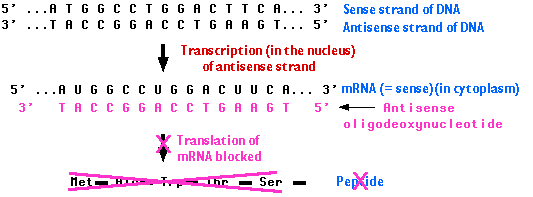Antisense Oligodeoxynucleotides
Antisense oligodeoxynucleotides (ODN)s are synthetic polymers:
- the monomers are deoxynucleotides like those in DNA
- there are usually only 15-20 of them, hence "oligo"
- their sequence (3´ -> 5´) is antisense; that is, complementary to the sense sequence of a molecule of mRNA.

Antisense ODNs are synthesized in the hope that they can be used as therapeutic agents blocking disease processes by blocking the synthesis of a particular protein. This would be achieved by the binding of the ODN to the mRNA from which that protein is normally synthesized. Binding of the two may
- physically block the ability of ribosomes to move along the messenger RNA or
- simply hasten the rate at which the mRNA is degraded within the cytosol
In order to be useful in human therapy, ODNs must
- be able to enter the target cells
- avoid digestion by DNAse
- not cause unpleasant side-effects
To achieve these goals, ODNs are generally
- chemically modified to resist digestion by DNAse
- attached to a targeting device such as
- the ligand for the type of receptors found on desired target cells
- antibodies directed against molecules on the surface of the desired target cells
Several laboratories are presently testing antisense ODNs as weapons against:
- HIV-1, the most frequent cause of AIDS in the United States
- cytomegalovirus (CMV); which frequently causes serious complications in AIDS patients
- asthma; inhalation of antisense ODNs reduces (at least in rabbits) the synthesis of cell receptors involved in asthma.
- certain cancers, e.g.,
chronic myelogenous leukemia (CML)
- certain types of inflammation caused by cell-mediated immune reactions
19 May 1999
